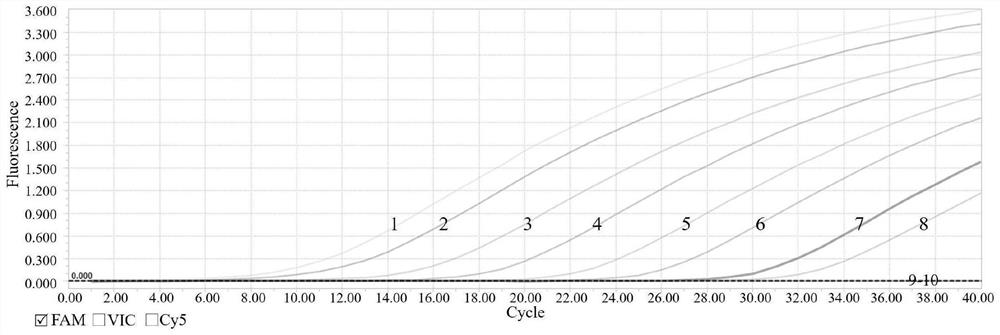Multiple real-time fluorescent quantitative PCR (polymerase chain reaction) primer, probe and kit for simultaneously detecting three types of echinococcus
A real-time fluorescent quantitative and Echinococcus technology, applied in biochemical equipment and methods, recombinant DNA technology, microbial measurement/inspection, etc., can solve the problems of harmfulness to operators and the environment, complicated operation, and low sensitivity , to achieve the effect of good quantitative linear range, simple operation and high sensitivity
- Summary
- Abstract
- Description
- Claims
- Application Information
AI Technical Summary
Problems solved by technology
Method used
Image
Examples
Embodiment 1
[0052] The sample is a positive plasmid standard containing target fragments of Em, Eg and Es, and is amplified by PCR using a Roche kit (RocheProbe PCRKit).
[0053] PCR amplification system: sample template 2 μl, 10 μm / L Em g s-F 1.5 μl, 10 μm / L Em g s-R 1.5 μl, 10 μm / L Em probe 0.2 μl, 10 μm / L Eg probe 0.2 μl, 10 μm / L Es probe 0.2μl, 2×ProbeMasterMix 10μl, RNA free H 2 O 4.4 μl.
[0054] Em g s-F: 5'-TTGTTTGCTATGTTTTCTATAGTGT-3'; SEQ ID NO.1;
[0055] Em g s-R: 5'-TCTTCACATCYAACCCAACAGT-3'; SEQ ID NO.2;
[0056] Among them, Y=C / T;
[0057] The probes used to detect Em are:
[0058] Emprobe: 5'-TTTAGGGAGTAGTGTTT-3'; SEQ ID NO.3;
[0059] The fluorescent group labeled at the 5' end is FAM, and the quencher group labeled at the 3' end is BHQ1;
[0060] The probes used to detect Eg are:
[0061] Eg probe: 5'-TTTGGGTAGCAGGGTT-3'; SEQ ID NO.4;
[0062] The fluorescent group labeled at the 5' end is VIC, and the quencher group labeled at the 3' end is BHQ1;
[0063] The p...
Embodiment 2
[0076] Embodiment 2 specificity test
[0077] Genomic DNA of parasites (Tenna polycephala, Taenia saginata, Taenia asiatica, Dipyridium canis, Taenia alveolar, Toxocara canis, Fasciola hepatica, Taenia lentiformis, Taenia centrum, Cryptosporidium canis) worm) and positive plasmid standard substance as template, carry out specificity test (test process is the same as embodiment 1), the results are shown in Figure 8 ; Figure 8 The results show that only Echinococcus multilocularis Em, Echinococcus granulosus Eg and Echinococcus shiqu Es positive samples have amplification curves, which are positive, and the rest of the control samples are negative, indicating that The method has good specificity.
Embodiment 3
[0079] The Ct values of the triple real-time quantitative method and the single real-time quantitative method were compared, and the results are shown in Table 3.
[0080] Table 3 Comparison of Ct values between the triple real-time quantitative method and the single real-time quantitative method
[0081]
[0082] Note: (triple: a pair of universal primers plus three probes; singleplex: a pair of universal primers plus a corresponding probe) for the detection of the same sample 1, sample 2, and sample 3.
[0083] The results in Table 3 show that the triple PCR simultaneous detection and the single PCR detection of the same sample have little change in the detection value, and the detection results are reliable.
PUM
 Login to View More
Login to View More Abstract
Description
Claims
Application Information
 Login to View More
Login to View More - R&D
- Intellectual Property
- Life Sciences
- Materials
- Tech Scout
- Unparalleled Data Quality
- Higher Quality Content
- 60% Fewer Hallucinations
Browse by: Latest US Patents, China's latest patents, Technical Efficacy Thesaurus, Application Domain, Technology Topic, Popular Technical Reports.
© 2025 PatSnap. All rights reserved.Legal|Privacy policy|Modern Slavery Act Transparency Statement|Sitemap|About US| Contact US: help@patsnap.com



